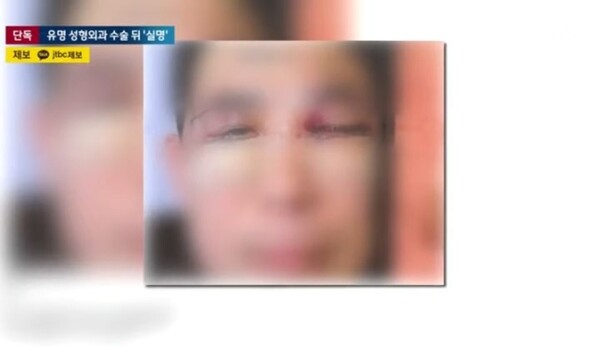Plastic surgeons criticized a recent case where a patient in his 50s reportedly lost vision in one eye following an under-eye fat repositioning surgery at a renowned plastic surgery hospital in Sinsa-dong, southern Seoul.

The hospital, established in 2004, is also famous for seeing a lot of foreign patients and deploys dedicated interpreters who can speak more than 20 languages, including English, Chinese, Japanese, Thai, and Arabic, for customer consultations and appointments, surgery, and recovery.
The hospital also advertises itself as one of the top plastic surgery hospitals in Korea that provides services ranging from facial contouring surgery to filler, and botulinum toxin treatment, that had provided treatment to over 6,000 foreign patients.
According to a Sept. 20 report by JTBC, a local TV broadcaster, the man underwent the surgery in May at the hospital without revealing the name of the hospital. After the surgery, the patient experienced severe swelling in his right eye.
The attending physician performed a secondary procedure on the same day to drain accumulated blood and then discharged him.
However, after being discharged, the patient could not see anything with his right eye in the evening of the day that he was discharged. Upon contacting the hospital the next day, he was told that this was “a common symptom that can appear after under-eye fat repositioning surgery,” the report said.
When his vision didn't return the following day, he revisited the hospital, where they advised him to seek consultation at a nearby tertiary hospital.
Upon arriving at the tertiary hospital, however, the doctor diagnosed the patient as blind due to damage in his optic nerve and said there was no way to restore his vision.
Regarding the case, a plastic surgeon specialist said the incident should have never happened, as stopping the bleeding is the most important factor when conducting lower blepharoplasty surgery, which is a collection of surgical techniques that aims to improve the appearance of the lower eyelids.
"The under-eye fat repositioning surgery, as the name suggests, involves the removal of fat from under the eye," a plastic surgeon in his 50s running a clinic in Jeju Island told Korea Biomedical Review. "This often leads to the fat retracting, and ensuring proper hemostasis becomes crucial."
If hemostasis is not performed correctly, it can lead to continuous bleeding, resulting in a hematoma.
The plastic surgeon mentioned that while hematomas on the skin can be treated with another surgery, the situation becomes gravely different for surgeries like under-eye fat repositioning.
"The retracting fat goes behind the eye, and any hematoma can compress the optic nerve," he said. "If not treated promptly, it can lead to blindness over time."
The expert also stressed that such incidents are rare and, importantly, something that plastic surgeons are trained extensively to prevent.
"One of the top priorities for plastic surgeons during these procedures is to manage bleeding," he said. "This event shouldn't occur if the surgery is done correctly."
He also stressed that in the event of such complications, immediate action is crucial.
"It's an emergency situation, and the focus should not be on potential scars or aesthetic concerns but on an immediate surgery to remove the hematoma," he advised.

Another university hospital professor agreed.
"In the lower eyelid, there are three sections of fat -- medial, central, and lateral," the professor said. "Some of this fat may be removed or repositioned during the procedure."
However, if done hastily or incorrectly, it can result in complications such as postoperative hemorrhage, he added.
The professor stressed that if immediate intervention isn't initiated in such cases, the pressure caused by a retrobulbar hematoma (a collection of blood behind the eye) can damage the optic nerve and other structures supplying blood and nutrients to the eye.
"In cases where the eye becomes engorged, or symptoms like severe orbital pain manifest, it's paramount to act swiftly," he said. "The bleeding must be controlled immediately to reduce the increasing pressure."
The expert also expressed concerns over how such mega-sized plastic surgery hospital manages patients.
"Such establishments often have intermediaries, such as call center agents, who may not recognize the urgency of certain symptoms," he said. "In contrast, smaller clinics or university hospitals often have direct communication lines with patients, allowing for faster response times in emergencies."
The expert stressed that this is probably what happened at the hospital in Sinsa-dong.
"The case at the Sinsa-dong hospital highlights the importance of understanding potential complications associated with even the most routine surgeries," he said. "Both doctors and potential patients should remain vigilant and well-informed about potential risks, as well as the critical need for swift intervention in case of complications."

